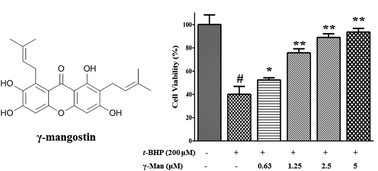Identification of hepatoprotective xanthones from the pericarps of Garcinia mangostana, guided with tert-butyl hydroperoxide induced oxidative injury in HL-7702 cells†
Abstract
Bioactivity-guided fractionation of an ethanol-soluble extract from the pericarps of Garcinia mangostana, using tert-butyl hydroperoxide (t-BHP) induced oxidative damage in human normal hepatocytes (HL-7702), led to the identification of 10 known xanthones. Among them, γ-mangostin (γ-Man) exhibited the most potent activity to attenuate t-BHP induced hepatocyte injury. γ-Man significantly ameliorated t-BHP induced reactive oxygen species accumulation, mitochondrial membrane depolarization and cell nuclei morphology change in HL-7702 cells. t-BHP decreased the intracellular levels of key enzymes including glutamate oxaloacetate transaminase and glutamate pyruvate transaminase, which was totally reversed by γ-Man. Moreover, γ-Man significantly decreased the level of lipid peroxidation and increased the levels of superoxide dismutase and reduced glutathione, resulting in the alleviation of oxidative stress. The above results suggest γ-Man is a potential hepatoprotective agent against t-BHP induced oxidative injury, which may benefit the further application of G. mangostana as a health food.


 Please wait while we load your content...
Please wait while we load your content...